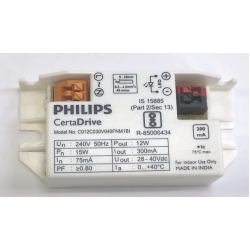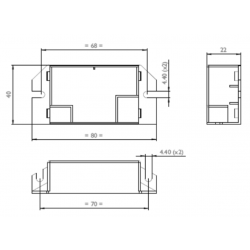LED DRIVERS

Philips LED Drivers are highly efficient LED driver for various applications
An LED driver is a self contained power supply which regulates the power required for an LED or array of LEDs. The light emitting diodes are low energy, lighting devices with a long lifespan and low energy consumption, hence the requirement for specialized power supplies. Philips led drivers are highly efficient LED driver that provide optimal performance in general lighting applications and in LED backlighting systems for large flat display panels. The Philips Surge Protection Devices are the ideal solution to the challenge of using LEDs in Outdoor lighting. The SPD protects the complete system against high surges that can occur due to for example lighting strikes. Essential for LED systems installed in high-risk areas, the advantages of using the SPD are not limited only to LED systems. The product can be used in any new or existing lighting solution, regardless of technology. Philips offers drivers from led driver manufacturers in Delhi .
Philips Xitanium Drivers - Products in this family
Reliability, flexibility and connectivity are the 3 pillars of our Xitanium outdoor LED drivers even though they have to face harsh conditions.
Philips Xitanium LED drivers are designed to meet EESL and other Outdoor project specifications. Our robust drivers are specifically designed to withstand high temperature, over-voltages, powerful vibrations, high dust and moisture levels, and surges of up to 6kV with minimum 50,000 hour lifetime. The fixed current output range consist of extremely reliable, robust drivers with low failure rates providing high confidence for those that need it most.
For ultimate performance and maximum flexibility, you choose programmable LED drivers for features like Dyna Dimmer, CLO, and current setting with SimpleSet – an effortless way to configure the driver without turning it on. A new standard for outdoor luminaire durability and efficiency.
Shop orangevolt.in for a complete line of LED Drivers. Explore the wide range of LED tube lights and LED battens. Let us help you find the right solution for you today.
LED Driver – FAQs
What is an LED Driver?
LED drivers are specialist power conversion devices used with LED equipment. What is an LED? A light-emitting diode is a small component made from an electrically conductive material. These emit light of different colours when current passes through, triggering the release of light particles called photons.
LEDs require a reliable power supply to operate. Drivers for LED lights supply this power, converting alternating current (AC) to direct current (DC). They ensure the power supply is constant and uninterrupted by compensating for changes in the temperature and electrical conductivity of the LEDs. This prevents overheating, flickering, colour changes and degraded performance.
LED drivers for lighting also offer thermal shutdown protection - this will switch off lighting altogether if the
temperature climbs too high. Most LED equipment is low Voltage. LED transformers perform the same function for
larger lighting systems that require more power.
Do All LED Lights Need a Driver?
Yes, all LED lights do require a bulb driver to operate but it is not always necessary to purchase these separately. Some models are supplied with an integrated driver - in particular, standard LED bulbs designed for use in domestic settings.
Lower voltage LEDs do normally require a separate driver, but this has one advantage. If the driver breaks, it can be
replaced without having to replace the bulb too.
What is LED Driver Used for?
LED lights are primarily low Voltage devices - typically 4v, 12v or 24v - and are designed for a direct current power supply. However, most wall socket power supplies are not directly compatible as these usually run at a much higher Voltage (between 120 and 277V) and supply alternating current. As the average Voltage of an LED is too low for a conventional transformer, specialist LED drivers are used to convert high voltage alternating current to low voltage direct current.
LED drivers have the secondary function of preventing power surges and fluctuations, which can cause high
temperatures and affect light output. LEDs are designed for use within a strict predetermined amp range.
Some LED drivers can also be used to control and sequence the brightness of the LED systems attached and the
colours which are displayed. This is done by selectively switching individual LEDs on and off. White lights, for example,
are usually created by displaying LEDs of multiple colours at once - switch some of these off via the LED and the white
colour is no longer visible.
How Do LED Drivers Work ?
Simply put, the forward Voltage requirements of an LED will vary as its temperature changes. As it becomes hotter the amount of Voltage needed to pull current into the LED will drop and it will therefore draw in more power. Left unchecked, the temperature would continue to climb, and the LED would burn out - a process known as thermal runaway. LED drivers feature power output levels that match LED requirements. The steady current supplied by the driver prevents thermal runaway by responding to changes in the forward Voltage.
How to Connect an LED Driver to Power ?
Although wiring an LED driver to mains power is straightforward, we would recommend that a qualified electrician inspects this to make sure the connections have been made safely. The process of connecting an LED driver to power consists of connecting the neutral and line wires to the PRI (primary) side of the driver, attaching the former to the N terminal and the latter to the L terminal. The positive and negative wires should then be taken from the LED lighting and attached to the matching terminals on the SEC (secondary) side of the driver.






























